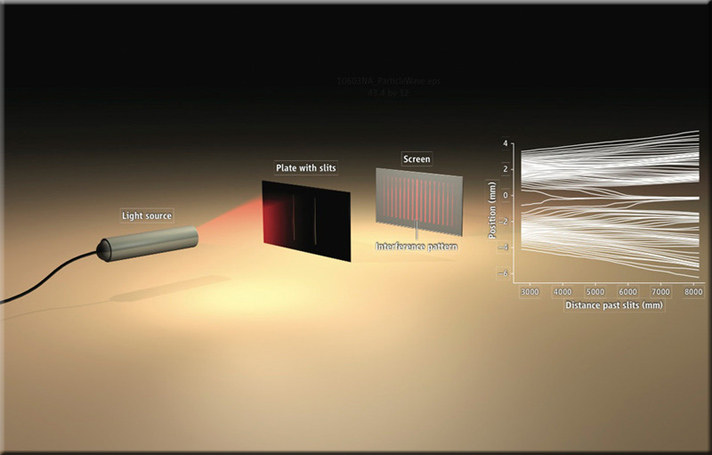 |
|||||
| Quantum Mechanics Gets Weirdly Less Weird | |||||
July 02, 2011 Uncertainty isn't quite what it used to be. For decades, one experiment has served as physicists' canonical example of the uncertainty principle: the law of nature that says you can't know both where a subatomic particle is and how fast it is moving, and thus can't trace its trajectory. But now physicists have tweaked that classic experiment to show that they can follow the average path taken by many particles, even though it's still impossible to talk about the path of any one of them.
The result shows that limits on what can be known are not as black and white as once thought. "Here you have a completely new type of experiment that is far deeper and is telling you much more" than the original experiment, says Sandu Popescu, a theorist at the University of Bristol in the United Kingdom, who was not involved in the work. In the famous two-slit experiment, scientists shine light through two parallel vertical slits in a thin plate and onto a distant screen (see diagram). The waves merging from the two slits overlap and interfere with each other to create a barcodelike pattern of bright stripes where the waves reinforce each other and dark stripes where they cancel each other. That "interference pattern" is a hallmark of wavelike behavior. However, light is a particle as well as a wave. So experimenters can detect the individual particles of light, or photons, as they hit the screen. Here's the bizarre part. If the light beam is dim enough, the photons will pass through the apparatus one by one. In that case, a reasonable person might expect the interference pattern to disappear, as it would seem that each photon would have to go through one slit or the other, eliminating the possibility of interference. But no, after enough photons pass through, the interference pattern once again emerges. So each photon must literally go through both slits at once and interfere with itself. Moreover, if the experimenter tries to determine which slit each photon goes through—say, by alternately closing one slit and then the other—the interference pattern really does disappear. The two-slit experiment shows that, depending on how it's measured, a photon will act like either a particle or a wave but not both. It also shows that one cannot know both exactly where the photon is (which slit it's going through) and what its momentum is (at what angle it emerges from the slit), making it impossible to define its path. But there is still information to be gleaned. Sacha Kocsis of Griffith University in Brisbane, Australia, Aephraim Steinberg of the University of Toronto in Canada, and colleagues have measured the average trajectories of many photons in the experiment, as they report in Science. Oddly, the trick is to make a measurement of each photon's momentum that is so weak it reveals essentially nothing about it. To do that, the researchers played with the light's polarization. A photon can be polarized in two mutually exclusive ways, right and left, or, thanks to the weirdness of quantum mechanics, both ways at once. The physicists began with photons in a 50-50 mixture of right and left polarization. That's the most uncertain state possible, as a measurement of any one photon's polarization will randomly yield right or left with 50% probability. After emerging from the slits, the photons passed through a crystal of the mineral calcite. Depending on the angle at which the photon traverses the calcite, it would slightly skew the photon's polarization from the 50-50 mixture. The effect couldn't reveal much about the momentum of one photon, as a measurement of its polarization would still yield left or right with roughly 50% probability. But it could reveal the average momenta of many photons. To extract that information, the researchers passed the photons through another widget before they hit the screen. It effectively measured each photon's polarization and deflected the left-polarized ones upward and the right-polarized ones downward. So two slightly different interference patterns emerged, one just above the other. For any horizontal position on the screen, the scientists could compare intensities of the two patterns to determine the average polarization mixture and, hence, the momentum of the photons reaching that position. With that information, they traced the average trajectories of the photons by simply repeating the process while backing up the screen to create a kind of map. The experiment doesn't violate quantum mechanics, Steinberg says; each individual photon still goes through both slits. But it does underscore an emerging, more-nuanced understanding of the theory, he says. "The textbook explanation has always been, if you don't ask [experimentally] about the photon's position in the apparatus, then you shouldn't even discuss it," he says. "I think some people are starting to reconsider that." Popescu agrees that, when it comes to measuring the positions and momenta of many particles, quantum mechanics isn't quite the either-or proposition that is commonly portrayed. "To a certain extent," he says, "quantum mechanics allows you to have your cake and eat it, too." Adapted from materials provided by Science |
|||||
